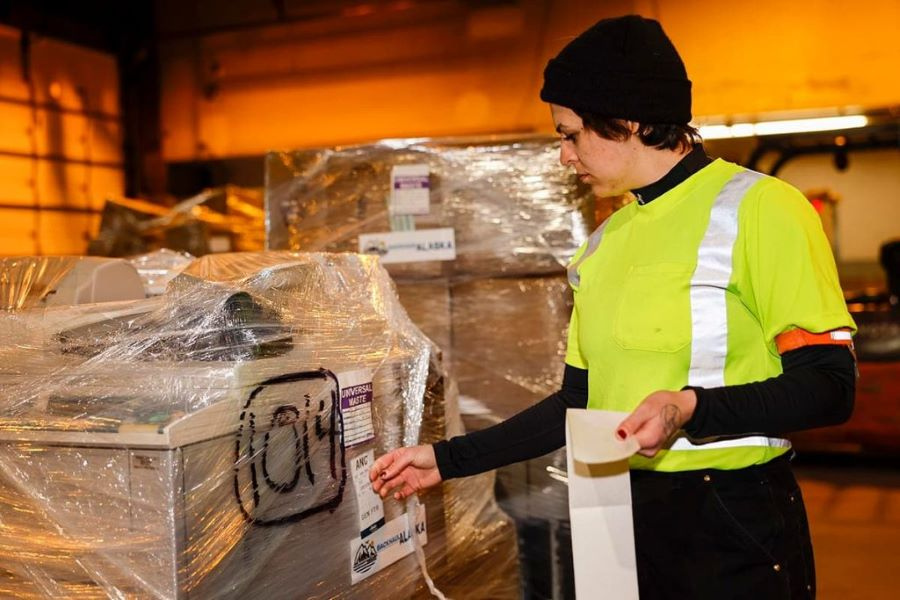
A plane takes off from Nome, Alaska with an e-scrap shipment on board as ballast. | Courtesy of Alaska Air Cargo
With a tiny population, no road access and over 500 air miles to the nearest medium-sized city, Nome, Alaska faces a multitude of e-scrap collection barriers. But a tribal nonprofit and an airline have overcome the conundrum with a weighty solution.
Alaska Airlines has begun loading e-scrap into the belly of its jets flying from far-flung Nome to the state’s largest city, Anchorage. The e-scrap serves as ballast to adjust the center of gravity and balance the plane. The materials replace a portion of the water that crews typically load on board to add weight.
The approach solves an environmental and logistics problem for the community, which is about six times closer to a sparsely populated region of Russian mainland than its own state capital.
“Respect for the land and nature is important to us,” Caitlin Auktweenna “Auk” Tozier, Alaska Airlines ramp agent in Nome, stated in an Alaska Air Cargo write-up. “Any recyclables we can carry out won’t have to remain in this community, where we don’t have the resources to process them.”
Two birds with one stone
In Nome, population 3,600, the collection and e-scrap shipment preparation is performed by a nonprofit services provider called Kawerak, Inc., which is governed by and serves Native peoples in the area. Tozier, who loads ballast on outbound flights and first conceived of the idea of using e-scrap instead of water, also works for Kawerak as a technology specialist.
She saw that outbound e-scrap shipments previously would have to sit for months waiting for a space on a barge headed to a recycling facility in Seattle, according to the write-up.
Rick Bendix, director of sales and marketing for Alaska Air Cargo, told E-Scrap News Kawerak estimates Nome and surrounding communities generate roughly 50,000 pounds of e-scrap each year. “This volume does not replace all of our ballast needs, but does replace the majority of it,” he said.
The e-scrap is later shipped from Anchorage to Seattle for recycling, according to Alaska Air Cargo.
The backhaul approach is somewhat akin to how ocean shipping lines have handled U.S. municipal recyclables such as corrugated cardboard, paper and plastics. For years, container ships have arrived at U.S. ports from Asia full of cargo, but there has been less demand for goods movement back west across the Pacific Ocean. Because the ships still need ballast for their return trips to Asia, U.S. exporters have been able to secure cost-effective rates for their recyclables bales.
Addressing battery concerns

Alaska Airlines ramp agent Auk Tozier attaches a shipping label to a pallet of e-scrap in Nome. | Courtesy of Alaska Air Cargo
In the Kawerak-Alaska Air Cargo collaboration, the e-scrap consists of very few CRT TVs and is mostly flat-screen TVs and monitors, the occasional projection TV, printers and copiers, Bendix said. It does not include laptops and cell phones because of concerns about batteries, he noted.
When asked what steps the airline has taken to ensure the e-scrap doesn’t contain damaged lithium-ion batteries that could ignite on board, Bendix said “Kawerak has a very strong sorting process to ensure they are only given us items that are not regulated for shipping by air.”
“The cargo also goes through an inspection process by Alaska Airlines personnel in Nome who are trained to be aware of and on the lookout for hazardous items during the acceptance process,” he added.
For Nome, the backhauls provide a logistics solution with an environmental benefit. Because landfills in the region have limited space, rural communities regularly burn garbage to save space.
“Materials come into our communities and they never leave,” said Anahma Shannon, Kawerak’s environmental program director. “Heavy equipment, lead-acid batteries, electronics, all these things – it’s so expensive to get them here, and nobody’s going to pay to get them out when they’re not worth anything. Our communities just get full of materials that aren’t good for their environment.”
That being said, the backhaul approach isn’t entirely new in the region. Kawerak has been working for over a decade with another airline, Bering Air, to move e-scrap, lead-acid batteries and fluorescent bulbs from smaller communities to Nome.
“By creating a system to get recyclables out of our communities, we’re helping them maintain a clean environment which improves human health,” Shannon said.



